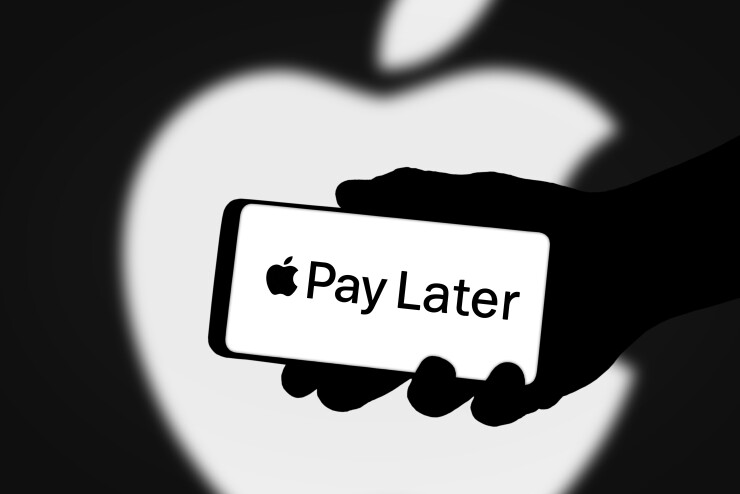
Any fintech players in the buy now/pay later market who feared the entrance of Apple have had little to worry about so far, as the rollout of
Since launching the BNPL service in March, Apple has offered early access to consumers it selects seemingly at random. Apple said it plans a broader rollout in "coming months," but observers hear very little buzz and see no competitive impact yet.
Apple Pay Later offers borrowers loans of $50 to $1,000 to be repaid in four equal payments over six weeks with no interest, with a linked debit card required for repayment. Mastercard Installments provides the connection to merchants, who will pay Apple a fee when consumers make purchases.
Perhaps the $1,000 limit is why Apple Pay Later didn't merit a mention when Apple unveiled its pricey $3,500 mixed-reality headset this week — a product that many people would need to finance.
The initial low visibility of Apple Pay Later contrasts with BNPL giant
Apple Pay Later targets users solely through the iPhone's digital wallet, and its unique approach may be one reason Affirm CEO
But some experts believe that behind the scenes, Apple is doing extensive testing and tweaking of Apple Pay Later to ensure it will eventually become a force competing with BNPL fintechs including Affirm,
"I'm skeptical about whether a company like Affirm is safe from the competition Apple Pay Later will later bring, and one reason is the very fact that they're moving very slowly and cautiously," said Charles Abraham, U.S. financial services practice leader in the Boston office of global tax and financial consulting firm Mazars.
It means little that Apple Pay Later's initial loans extend no longer than six weeks and up to $1,000, compared to Affirm's BNPL loans that can stretch up to 60 months and as high as $25,000, Abraham said.
"I believe $1,000 is just a starting point for Apple and it's almost certain they will eventually go much higher," Abraham said.
Apple is notorious for coming late to a market and pulling ahead of long-established competitors. It did this with the launch of the iPhone, Apple Watch, Apple Pay and other items that make up its consumer product set.
Apple Pay Later's strategy of marketing itself directly to consumers allows the company to target only the best prospects, which is an advantage during the current period of deteriorating consumer quality and a weakening economy, Abraham said.
Apple notifies users that Apple Pay Later is available in their digital wallet alongside Apple's growing array of financial services, which now includes a
"Apple Pay Later's goals are simple. First, reduce friction points for consumers who want to shop through Apple and finance a purchase. Second, use these loans to tie people more closely into Apple's overall financial ecosystem," he said.
Apple Pay Later's rollout also builds on growing awareness of Apple Pay and the Apple Cash digital wallet, which is a positive, he noted.
Twenty-seven percent of consumers have made a peer-to-peer payment during the past year using Apple Pay or Apple Cash, according to Aite-Novarica, which pulled the data from a study of 5,895 consumers during the first quarter of this year.
The fact that the Apple Pay Later rollout is moving slowly likely means that Apple has different goals than the biggest BNPL fintechs, said Ariana-Michele Moore, an advisor in Aite-Novarica's retail banking and payments practice.
"Apple Pay Later fits into the core of Apple's revenue model, where it's one more tool for Apple loyalists to fund their purchases and make them part of Apple's growing ecosystem," Moore said.
By this logic, Apple could gain momentum with Apple Pay Later organically, potentially catching up to or passing rivals over time, she said.
Analysts said Apple's other advantage versus BNPL fintech rivals is its funding of Apple Pay Later loans through the deep pockets of its in-house Apple Financing LLC subsidiary. Most BNPL fintechs are continuously scrambling for capital from third parties to fund their loans in a steepening interest-rate environment, giving Apple another market advantage, they say.
Apple said from the start that it plans to report borrowers' loan activity to credit bureaus, which puts it a step ahead of BNPL fintechs who tend to have an uneven record of reporting their customer data.
That gap has led many observers to predict the
Affirm last month said it's forming a






